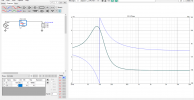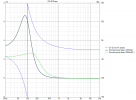- Joined
- Jun 19, 2018
- Messages
- 6,652
- Likes
- 9,408
In the spectrogram tab
View attachment 98334
You can change the appearance settings as well -- just change it to whatever method or resolution is needed to see things clearer.
FDW doesn't affect the spectrogram at all, but it can clear up some of the reflection-induced rotations in seen in the phase traces.
From REW's help doc:
Fourier or Wavelet.
In Fourier mode the plot uses fixed width windows, which mean the plot has the same time resolution at all frequencies. If the plot spans a wide range of frequencies this usually means the time resolution is either too low at high frequencies or too high at low frequencies. A 100 ms window, for example, gives 10 Hz frequency resolution. At low frequencies that is a big octave fraction (1/1.4 octaves at 20 Hz), at high frequencies a very, very small octave fraction (1/1386 octaves at 20 kHz).
For a time-frequency plot it would be more useful if the tradeoff between time and frequency resolution varied with frequency, using a constant octave fraction for frequency resolution rather than a constant number of Hz and so giving higher time resolution at high frequencies and lower at low frequencies. A wavelet transform can achieve that, specifically a constant Q Continuous Wavelet Transform (CWT). A constant Q wavelet transform is mathematically equivalent to using a frequency-dependent window to produce the spectrogram, which is what REW does.
---
The wavelet view is a favorite of mine. You can see reflections and resonances found in the impulse and ETC, and the broken solid track lines also seem to correlate well with the actual phase itself (best when zoomed-in really close).
Ok, thank-you! This is not the first time I've given bad advice due to incompetently trying to view something in REW. I'll edit my post to remove the misleading info





